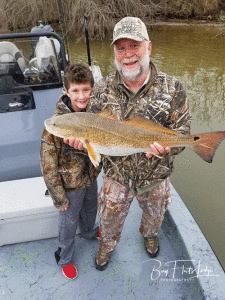
Shallow Red
Well, it has finally happened. It has gotten cold along the Gulf coast of Texas. Not only does this mean we can expect to see driving winds this month, but we’ll probably also experience some extremely foul weather at times, as well. Icy wind and chilling rain are two really good reasons why a lot of people choose not to fish during colder times of the year. However, many dedicated saltwater anglers who are willing to combat the elements in order to spend a day on the water can often recognize great rewards for their efforts. Some of the year’s largest trout can expect to be taken this month and next, but anglers should also recognize the need for them to possess a great deal of patience and perseverance in order to locate and land one of these behemoth cold-water gals.
Coastal anglers should expect to find fish in deeper water this month, especially if the weather turns extremely cold. Common deep bodies of water in our general vicinity include places such as the Army Hole that’s located just next to Pringle Lake out on Matagorda Island, the stretch of the Intracoastal Waterway from West Matagorda Bay to San Antonio Bay, and the Victoria Barge Canal which starts near the town of Seadrift. These are deep places that tend to hold fish during periods of extreme cold, but anglers don’t need to limit their search here. When temperatures drop, but are still not near freezing, wintertime trout and reds will often relocate to water that’s just a bit deeper than that where they were previously located just prior to the drop in temperature. This means anglers should also investigate area drains and ditches, canals, bayous, guts and creeks, especially any which happen to be situated just adjacent to a sandy, muddy, or grassy flat that allows a warming spot for the fish in between wintertime frontal passages.
The midpoint between cold fronts often provides a lull in the wind and some much needed warmth from the sun. During such days in January, anglers should look to some of the larger oyster reefs that populate the open waters of San Antonio Bay. And when the barometric pressure begins dropping in advance of the next approaching frontal passage, anglers will commonly be pleased when they discover the trout bite to be just a little better than normal as the fish tend to start preparing themselves for the onslaught of more cold weather. Happy New Year to you, and yours! Keep grindin’!
